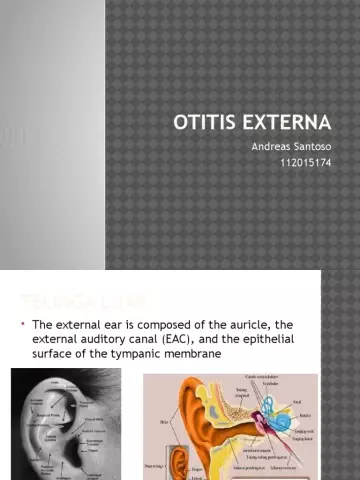- Author Rachel Wainwright [email protected].
- Public 2023-12-15 07:39.
- Last modified 2025-11-02 20:14.
Belmo
General characteristics of the disease

A thorn in the eye or leukemia is called corneal opacity. It is caused by cicatricial changes on the cornea of the eye, caused by a number of reasons. In the process of scarring, the cornea loses its transparency and the ability to freely transmit light. An eye with a thorn becomes a specific porcelain white color. Over time, the color of the leucorrhoea changes slightly: it grows into a network of blood vessels, undergoes fatty degeneration and becomes a yellowish tint.
The effect of a thorn in a person's vision can be different. In some cases, an eyesore leads to complete blindness. Although with this pathology, the situation of only partial loss of visual acuity is also not excluded. The quality of vision depends on the size of the leucorrhoea and its location on the cornea.
The formation of a leucorrhoea in the center of the cornea, directly opposite the pupil, leads to the maximum complications. Peripheral localization of corneal opacity has little effect on visual acuity. In this case, the size of the cicatricial formations on the cornea also plays an important role in the quality of vision. The most dangerous is a large thorn in the central part of the eye.
Multiple small leukomas can often only be detected with ophthalmic equipment. They lead to a slight loss of visual acuity, and a person is often unaware of the existence of a thorn in him.
Types of eyesore
Thorns in the eye can be congenital, caused by intrauterine inflammatory processes. This is the most rare type of corneal scarring pathology.
Most often, a thorn is an acquired phenomenon. The postponed inflammatory process of the cornea - the so-called keratitis - can provoke the formation of multiple scars. It is of syphilitic or tuberculous origin. And in both cases, keratitis leads to massive scarring of the cornea.

Acquired eyesore, as one of the consequences of corneal ulcers, is combined with significant thinning of the cornea and intraocular pressure pathologies. This type of eyesore is called ectazed (convex) leukoma.
A chemical burn or corneal trauma can also provoke the formation of an eyesore. Alkaline burns are especially dangerous for eyesight. After them, a person can retain the ability of the eye only for light perception.
Serious penetrating trauma to the eye often causes the cornea to fuse with the iris. This situation can cause the development of secondary glaucoma (blurred pupil). There is also the likelihood of corneal scarring and the formation of a thorn in the eye as a result of an unsuccessful ophthalmic operation.
Treating eyesore
Treatment of a leucorrhoea is mainly surgical. According to statistics, the most favorable prognosis in the treatment of eyesore is observed in diseases of infectious etiology. In this case, the patient undergoes conservative therapy of the underlying disease, and then he is sent for surgical treatment of the leucorrhoea.
The corneal plasty technique can achieve significant results in improving the quality of vision. Surgical treatment of leucorrhoea is carried out by transplanting a donor cornea to the patient. Through and partial implantation of the donor cornea is possible.
The prognosis for the treatment of a leucorrhoea of a traumatic or burn nature depends on the nature and severity of corneal damage. In cases of massive destruction of the corneal epithelium and the exposure of a large number of nerves, an intraocular protective lens is installed. This method of surgical treatment of leucorrhoea leads only to the relief of the patient's condition. A person's photophobia, lacrimation decreases, but vision is not fully restored.
With a minimal severity of corneal opacity at the periphery of the organ, surgical treatment of a leucorrhoea is not performed. In this case, the patient is shown dynamic observation and conservative treatment of an erythematosus to raise local immunity.
Alternative treatment of eyesore
In the folk treatment of eyesore, lotions with eyebright infusion are used. It is prepared at the rate of 1 tablespoon per glass of water, infused for an hour, filtered and cooled. It is recommended to apply cotton swabs with eyebright infusion to the eyes for 20-30 minutes daily. Eyebright infusion can also be drunk in a quarter of a glass 3 times a day.

Another way of folk treatment for eyesore is to bury the eyes with a mixture of red onion juice with honey in proportions of 1: 1.
In the folk treatment of eyesore, breast milk is also used. It should certainly be instilled fresh in the patient into the affected eye.
The most exotic way of folk treatment for eyesore is considered to be instilling the eyes with bile of fresh pike.
The effectiveness of the above-mentioned methods of folk treatment of eyesore has not been confirmed by official medicine.
YouTube video related to the article:
The information is generalized and provided for informational purposes only. At the first sign of illness, see your doctor. Self-medication is hazardous to health!






